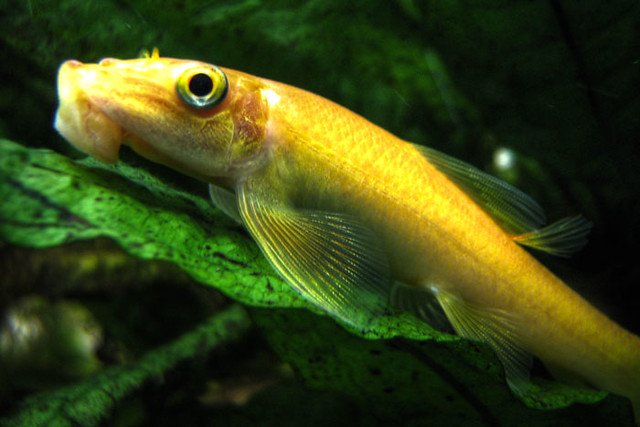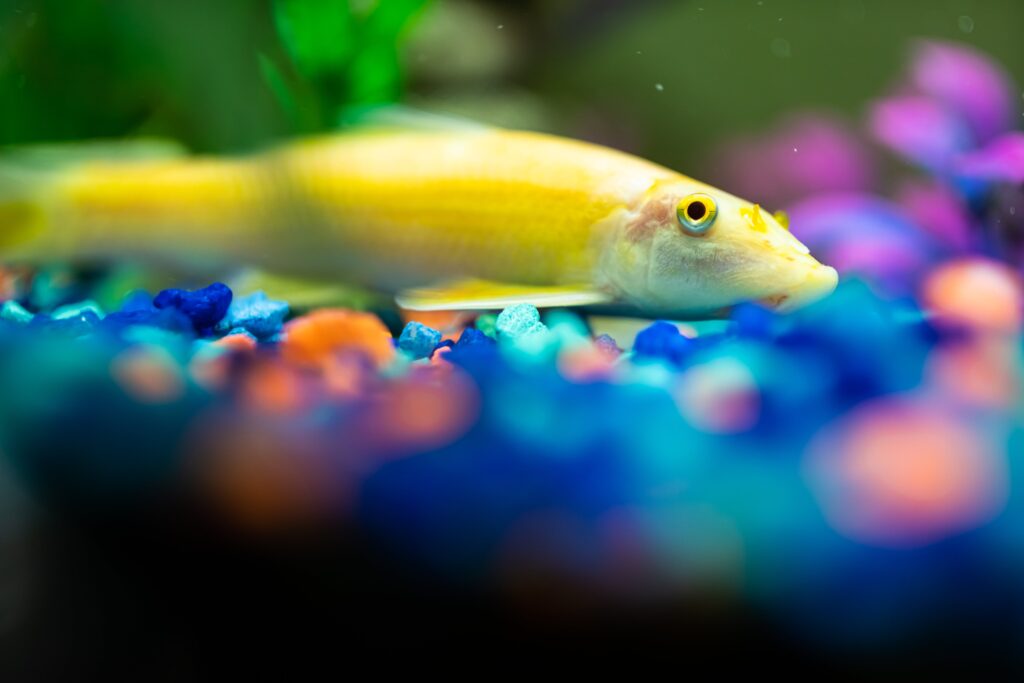Chinese Algae Eater
Though lacking the vibrant colors of other fish, the Chinese Algae Eater – Gyrinocheilus aymonieri, is a hardworking addition to an aquarist’s collection. At their juvenile stage, they effectively control algae growth in a tank.
- Experience Level: Beginner
- Hardiness: Hardy
- Minimum Tank Size: 30 gal (115 L)
- Maximum Size: 10 inches (25 cm)
- Temperament: Peaceful
- Temperature: 75 – 78° F (24 – 25.5° C)
- pH Range: 6 – 8
- Water Hardness: 5 – 20 dGH
- Diet: Omnivore
Table of Contents
Introduction
Size and Appearance
Care Guide
Tank Mates
Diet and Feeding
Breeding
The “Chinese” moniker of the Chinese Algae Eater can be quite misleading. It’s not exclusive to China, although some specimens have been found in China’s Yunnan Province. However, the majority of their population can be found in Southeast Asia, specifically in places such as Cambodia, Vietnam, Thailand and Laos.
In Cambodia, where the species is commonplace, it rarely serves as an aquarium fish. Rather, it is farmed and sold in markets for use in the preparation of a Cambodian cheese known as “prahok”, a fermented fish paste that plays a central role in Khmer cuisine.
Naturally found in clear, shallow waters with gravel, stones, sand, and pebbles on the bed these fish can commonly be observed in areas that receive a good amount of sunlight, which aids in the development of biofilms on rocky surfaces. Chinese Algae Eaters take part in seasonal migration and can navigate deeper, fast-moving waters. Despite robust currents, they skillfully anchor themselves to rocks and other underwater terrain.
Size and Appearance
The Chinese Algae Eater has a long body resembling those of bottom-surviving loaches, earning it the name “Chinese Loach.” In captivity, with proper care, a Chinese Algae Eater can live between 5 to 10 years.
While juvenile Chinese Algae Eaters are merely 1 to 2 inches long, they mature to an average length of 4.5 inches (12 cm). In the wild, they can grow to up to 11 inches (28 cm). However, the largest captive specimen I’ve seen in a tank was a 6-inch adult.
Chinese Algae Eaters don’t possess the vibrant colors many associate with aquatic creatures. They are primarily brown, with wild specimens tending to be even more pale than their captive counterparts.
A black side stripe adorns these fish, beginning at the nose tip and trailing back to the tail. This stripe can sometimes appear fragmented. Black spots may also dot the back and tail fin.
Aside from common forms, there are also several color variations, including albino, marble, and lecustic. Interestingly, the Albino Chinese Algae Eater is quite colorful and is very sought after for adding color to home aquariums. It is also known as the Golden Algae Eater and lacks the black lines or spots, trading them for a brilliant yellow hue.
The Chinese Algae Eater is equipped with a unique underslung mouth and pronounced lips, which help them secure themselves to rocks. These fish are adept at maintaining their position in fast-moving water via their sucker-like mouths.
What’s even more fascinating is that the Chinese Algae Eaters can breathe with their mouths closed due to their gills’ dual branching design. This neat adaptation allows water to flow in through one branch and out the other, enabling the fish to remain attached to surfaces while feeding without being swept away.
The Chinese Algae Eater, also known as Sucker Loach, Honey Sucker, and Biforated Carp, is different from the Siamese Algae Eater (Crossocheilus atrilimes) and Red Algae Eater (Crossocheilus langei.) Despite physical similarities, they belong to a different genus and lack the signature sucker mouth of the Chinese Algae Eater.
Similar to the Chinese Algae Eater, the Siamese and Red Algae Eaters roam the bottom of the tank for algae. However, they can eat a wider variety of algae than their counterpart.
Care Guide
- Minimum Tank Size: 30 gal (115 L)
- pH Range: 6 – 8
- Water Hardness: 5 – 20 dGH
- Temperature: 75 – 78° F (24 – 25.5° C)
- Lighting: Moderate, diffused lighting
- Substrate: Fine sand/gravel
- Brackish: No
- Water Flow: Weak/Low
- Tank Region: Bottom and on plants
Chinese Algae Eaters are quite undemanding in terms of care, provided there’s availability of clean, oxygen-rich water, and contrary to widespread belief, algae is not their main food source.
The Chinese Algae Eater is a sturdy species that adjusts comfortably across a range of water parameters, with optimum water hardness ranging between 5 to 20 dGH.
Pleasingly, these fish accommodate pH levels between 6.0 to 8.0. Inspired by their natural habitats that enjoy sunlight exposure, aim to maintain water temperature in the range of 75° F to 78° F (24° C – 25.5° C).
A vital quality of your tank should be the oxygen level and a moderate to robust water current.
Engage in partial water changes (30% to 50%) at least once a month to limit ammonia and nitrite levels. If the tank is overpopulated, water changing intervals may need to be closer together.
Maintaining good tank hygiene involves scrubbing the tank to get rid of slime and mineral build-up. Standard or magnetic algae scrapers work well for this purpose. Meanwhile, your Chinese Algae Eater would be pleased to handle algae growth on rocks and secluded spots.
A 30-gallon tank would suffice for a juvenile Chinese Loach, but as it matures, a 55-gallon tank (208 liters) or more is essential. If you plan to keep a pair, you’ll need at least a 125-gallon tank.
In replicating their natural habitat which parent water bottoms layered with stones, pebbles, sand, and gravel along with toppled trees, opt for aquariums with sand substrate and rock and slate formations.
River rocks make excellent choices for these. Ensure cleaning by immersion in hot water prior to introducing them to the tank. This kills harmful bacteria and pathogens.
As Chinese Algae Eaters don’t damage plants, feel free to include aquatic plants that are beneficial to other tank residents. Growing moss on rocks further enhances the aquarium’s natural feel.
The preference for Chinese Algae Eaters leans more towards moderate to normal illumination. Diffused, filtered natural light proves best.
Tank Mates
The Chinese Algae Eater tends to be more introverted, preferring to keep to itself. Chinese Algae Eaters in their juvenile stage are excellent for community aquariums due to their indifference to other fish. Their behavior can, however, change after maturing and can turn aggressive.
Chinese Algae Eaters might harass each other if kept as a pair due to their competitive nature. However, it may be feasible to get a pair for a 125-gallon tank or larger. Avoiding conflict essentially involves letting the other fish stay clear of the Chinese Algae Eaters’ space.
Bottom-dwelling species of similar sizes or smaller usually end up being viewed as competitors for food. Chinese Algae Eaters are even prone to hassle slow-moving tank mates, like snails, and may attach themselves to large flat-bodied fish to consume the protective slime layer covering the fish’s body.
Contrarily, ideal tank mates for Chinese Algae Eaters can be fast, peaceful fish that frequent the upper layer of the tank including
- Dwarf Gourami
- Emperor Tetra
- Molly Fish
- Platies
- Tiger Barbs
- Zebra Danios
Feeding Guide
- Diet: Omnivore
- Frequency: Several small feedings per day
- Pellet Foods: Yes
- Flake Foods: Yes
- Live Foods: Yes
- Meat Foods: Yes
- Vegetable Foods: Yes, will often take partly cooked, dark leafy greens and other produce as noted below
In their natural habitat, juvenile Chinese Algae Eaters extract nutrients by grazing on algae on rocks. This behavior will likely be carried over in captivity.
However, as they grow older, they shift from being completely algivorous to being omnivorous. Adult Chinese Algae Eaters prefer insects, crustaceans, larvae, and maggots that they can gulp down.
Consequently, providing a balanced diet is critical to maintain their health. Algae wafers and top-quality sinking pellets are ideal staple foods for these bottom-feeding omnivores.
Additionally, they could benefit from infrequent servings of cut fruits and blanched vegetables which may include:
- Apple
- Grape
- Papaya
- Pear
- Carrot
- Cucumber
- Romaine lettuce
- Shelled peas
- Spinach
- Zucchini
Live or freeze-dried brine shrimp, daphnia, and bloodworms offer a good protein source.
Breeding
Sexing Chinese Algae Eaters can be problematic, making them tricky to breed. Predominantly, the stocks available in pet shops are sourced from hatcheries that utilize hormone-induced breeding methods. However, a few cases of accidental breeding in ponds have been reported.
If you plan on breeding Chinese Algae Eaters, keep a large group in a pond and adjust water temperatures to stimulate natural reproductive behaviors. And of course, you’ll need a healthy dose of luck!



